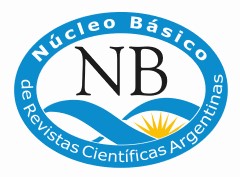EL DESGASTE PROFESIONAL CRÓNICO (BURNOUT) EN DOCENTES E INTEGRANTES DE EQUIPOS DE SALUD EN CIUDADES ARGENTINAS
Resumen
Introducción. Con el objeto de cuantificar el desgaste profesional crónico, conocido como burnout, y sus características particulares en docentes de educación primaria, media, universitaria y también en integrantes de los equipos de salud, en distintas etapas de la vida profesional, a lo largo de los años y en distintas provincias del país, se ha llevado a cabo la presente investigación. Material y métodos. Diseño observacional, transversal y analítico. Las investigaciones se desarrollaron entre los años 2003 y 2016; en algunas localidades los relevamientos de información fueron realizados en más de un oportunidad y en diferentes años, siempre con la misma metodología. La recolección de datos se realizó mediante encuestas de autocomunicación con el Inventario de Burnout de Maslach (MBI, su sigla en inglés), instrumento validado para el idioma español. El muestreo fue no probabilístico. El análisi estadístico fue con prueba t para las variables cuantitativas y χ2 para las variables cualitativas; el análisis multivariado se efectuó con regresión logística. Se usaron los programas SPSS 17.0 y Primer. En ninguna oportunidad se recibieron subsidios para la investigación. Resultados. De 565 docentes (80,5% de enseñanza media y 19,4% de universitarios) evaluados, presentaban burnout el 11,4% en el nivel primario y medio y el 8,0% en el nivel universitario; el índice de desgaste profesional crónico fue significativamente mayor en los colegios de nivel medio y en los del interior de Córdoba. En el equipo de salud, el 77,1% eran médicos (36,8% de especialistas y 40,2% de residentes) y el 22,9%, profesionales no médicos. El burnout fue variable, con medias, respectivamente, de entre el 26,0% y el 44,0% en los médicos y del 19,0% en el resto de los profesionales. Conclusiones. La tasa de burnout fue más alta en los equipos de salud que en los docentes; en los equipos de salud fue más alta en los médicos y significativamente en la etapa de la residencia en hospitales escuela; parecería menor en el ámbito privado. La escala MBI tiene aceptable confiabilidad; no existe coincidencia entre las variables predictoras. La tasa de burnout sería menor en Córdoba que en Catamarca y La Rioja; parece significativamente creciente con el tiempo y se situaría en un nivel cercano al 50%.
Palabras clave. Burnout, desgaste, docentes, equipo de salud, salud profesional.
BURNOUT IN TEACHERS AND HEALTHCARE TEAM MEMBERS IN ARGENTINE CITIES
Abstract
Introduction. With the object of quantifying burnout and their inherent characteristics among teachers of primary school, middle school, university faculty, and also in healthcare professionals, along the different stages of professional life, over different years and in different provinces of Argentina, we have undertaken this research. Material and methods. The design has been cross-sectional, observational, analytical. The research has been conducted between 2003 and 2016; in some locations the surveys were carried out on more than one occasion and in different years, always using the same methodology. The data collection was made by means of self-reported surveys applying the Maslach Burnout Inventory (MBI), an instrument validated for the Spanish language. The sampling was not probabilistic. The statistical analysis was performed using t-test for quantitative variables, and χ2 chart for qualitative ones. For the multivariate analysis we used logistic regression. SPSS 17.0 and Primer
software has been utilized. We have received no funding for the research. Results. Of 565 teachers (80.5% of middle school and 19,4% at university level) assessed, 11.4% in primary and secondary level teachers and 8.0% of university faculty had burnout; burnout rate is significantly higher in secondary teaching staff and in those of the interior of Cordoba. In healthcare team, 77,1% were doctors (36.8% of specialists and 40.2% of residents) and 22.9%, non-doctor professionals; the degree of burnout was variable, with averages between 26.0% and 44.0% in doctors and 19.0% in other healthcare professionals. Conclusions. Burnout was mostly observed in healthcare team members than in teachers; in the healthcare team it was higher among doctors and even particularly higher in resident doctors of teaching hospitals; burnout seems to be lower in private hospitals; MBI has acceptable reliability; there was no match among predicting variables; burnout was lower in Cordoba than in Catamarca and La Rioja; it seems to be significantly increasing over time and it would be at around 50%.
Key words. Burnout, teachers, faculty, healthcare team, professional health.











 Esta obra está bajo una
Esta obra está bajo una 